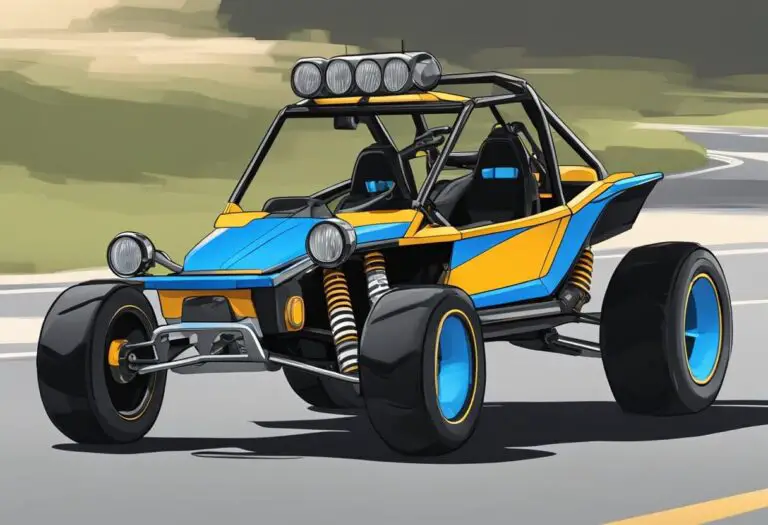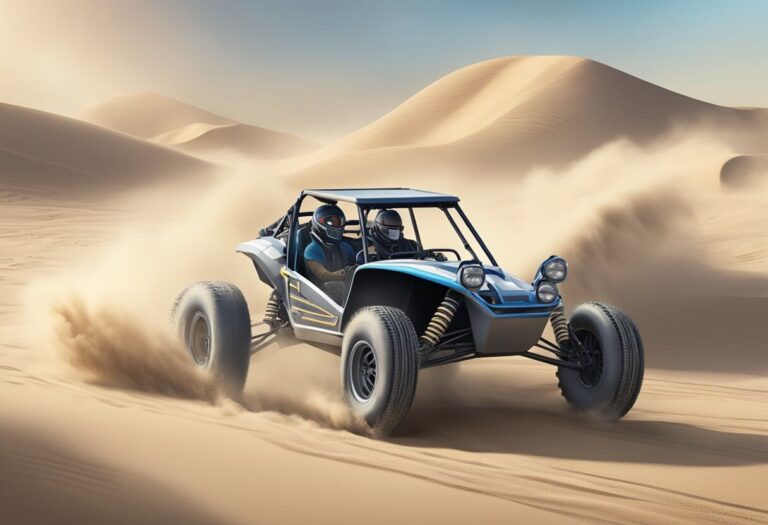Off Road Dune Buggy: Ultimate Guide to Choosing Right Model
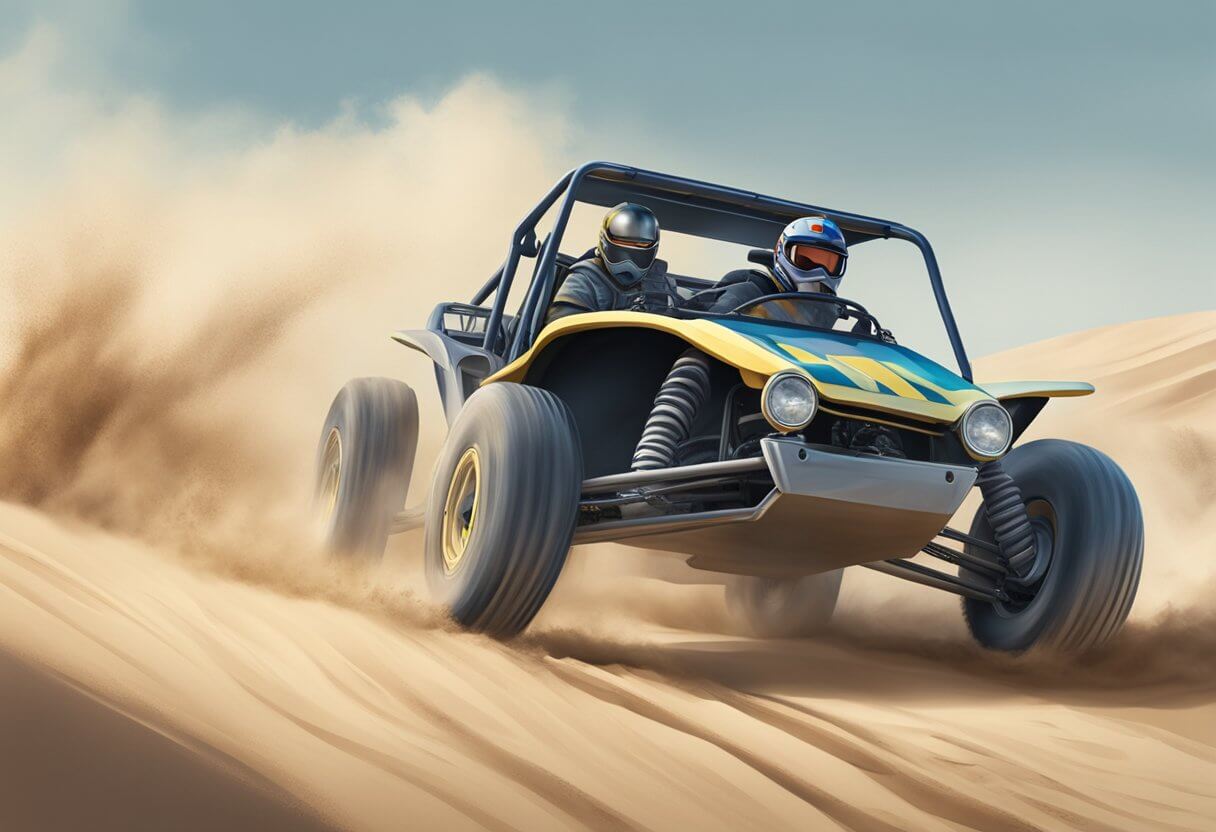
Off road dune buggies are a popular type of vehicle for those who enjoy exploring the great outdoors. These vehicles are designed to handle rough terrain, such as sand dunes and rocky trails, and provide a thrilling ride for drivers and passengers alike.
One of the main advantages of off road dune buggies is their versatility. They can be used for a variety of purposes, from recreational activities like off-roading and sand dune racing, to more practical applications like farming and ranching. With their sturdy construction and powerful engines, off road dune buggies are capable of handling a wide range of terrain and weather conditions.
When it comes to choosing an off road dune buggy, there are many factors to consider. Some important considerations include the type of terrain you plan to drive on, the size and weight of the vehicle, and the features and accessories that are available. By doing your research and carefully weighing your options, you can find the perfect off road dune buggy for your needs and enjoy all the excitement and adventure that this type of vehicle has to offer.
History of Off-Road Dune Buggies
Off-road dune buggies have a rich history that dates back to the late 1940s. During this time, people began modifying cars to create lightweight, high-performance vehicles that could navigate the sand dunes of California. Bruce Meyers is credited with creating the first true dune buggy, which he called the Meyers Manx.
The Meyers Manx was a fiberglass-bodied buggy that was built on a shortened Volkswagen Beetle chassis. The buggy was designed to be lightweight, with a simple yet effective design that could handle the rugged terrain of the desert. The Manx became an instant hit, and soon dune buggies were popping up all over California.
As the popularity of dune buggies grew, so did the number of manufacturers. Companies like Berrien Buggy, Desert Dynamics, and Sand Rocket began producing their own versions of the dune buggy. These buggies featured more advanced designs and were built using stronger materials like chromoly steel.
Today, off-road dune buggies are still popular among enthusiasts. They are used for a variety of purposes, including racing, recreation, and exploration. Modern dune buggies are often equipped with high-performance engines, advanced suspension systems, and other features that make them capable of handling even the toughest terrain.
Types of Off-Road Dune Buggies

Off-road dune buggies come in different types, each designed for specific terrains and driving conditions. In this section, we’ll take a look at three of the most popular types of off-road dune buggies: Sand Rails, Rock Crawlers, and All-Terrain Buggies.
Sand Rails
Sand rails are lightweight, high-performance dune buggies designed for sand dunes and beaches. They are built with a tubular frame and a powerful engine that can generate high speeds on sand. Sand rails are typically rear-wheel-drive and feature large, paddle-style tires that provide excellent traction on sand.
Sand rails come in many different shapes and sizes, from two-seaters to four-seaters, and are popular among off-road enthusiasts who love the thrill of driving on sand.
Rock Crawlers
Rock crawlers are off-road dune buggies designed for rocky terrain and steep inclines. They are built with a sturdy frame and heavy-duty suspension that can absorb shocks and bumps while climbing over rocks and boulders. Rock crawlers are typically four-wheel-drive and feature large, knobby tires that provide excellent traction on rocks.
Rock crawlers are popular among off-road enthusiasts who love the challenge of navigating rocky terrain and conquering steep inclines.
All-Terrain Buggies
All-terrain buggies are versatile off-road dune buggies designed to handle a variety of terrains, including sand, rocks, mud, and dirt. They are built with a sturdy frame and a powerful engine that can generate high speeds on any terrain. All-terrain buggies are typically four-wheel-drive and feature large, all-terrain tires that provide excellent traction on any surface.
All-terrain buggies are popular among off-road enthusiasts who want a dune buggy that can handle any terrain and provide a thrilling off-road experience.
Design and Engineering

Chassis and Frame
The chassis and frame are the backbone of any off-road dune buggy. The design and construction of the chassis and frame can significantly affect the performance and durability of the vehicle. The chassis should be lightweight and sturdy enough to withstand the stress and strain of off-road driving.
Most off-road dune buggies use a tube frame chassis made of chromoly steel. Chromoly steel is stronger and lighter than regular steel, making it an ideal choice for off-road vehicles. The frame should be designed to provide maximum ground clearance and stability.
Suspension Systems
The suspension system is another critical component of an off-road dune buggy. A well-designed suspension system can provide a smooth ride and improve the vehicle’s handling on rough terrain.
There are several types of suspension systems used in off-road dune buggies, including independent front suspension, solid axle rear suspension, and long-travel suspension. The type of suspension system used will depend on the intended use of the vehicle.
Engine and Transmission
The engine and transmission are essential components of an off-road dune buggy. The engine should provide enough power to handle the rough terrain and steep inclines.
Most off-road dune buggies use a modified Volkswagen air-cooled engine. These engines are reliable and easy to maintain, making them a popular choice for off-road vehicles. The transmission should be designed to handle the stress and strain of off-road driving.
Safety Features
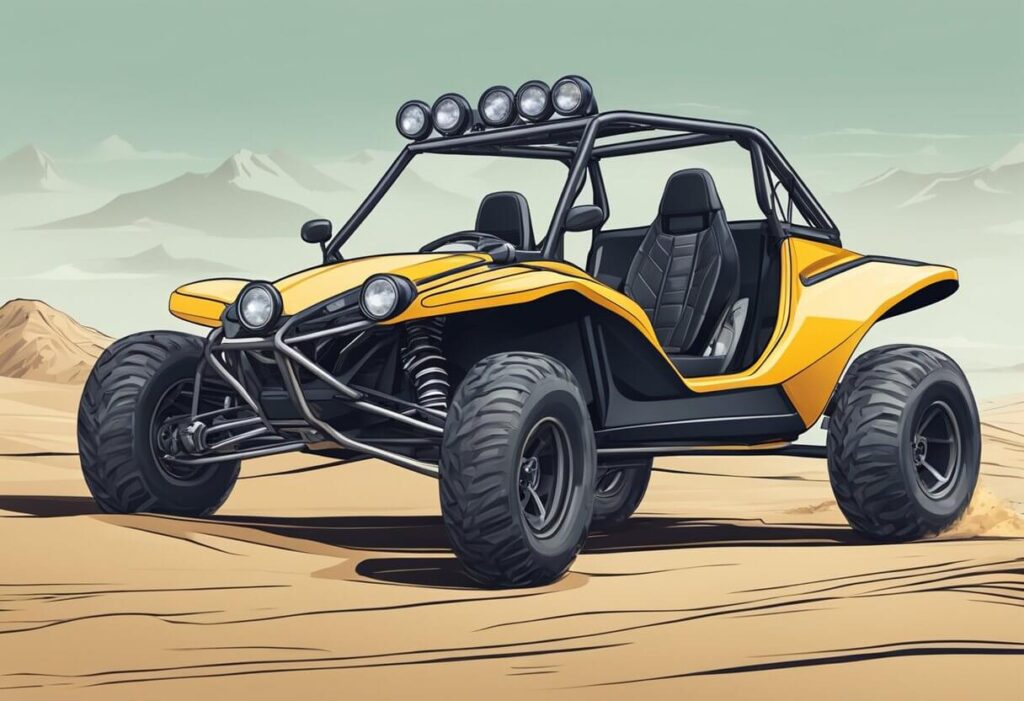
When it comes to off-road dune buggies, safety should always be a top priority. Here are some essential safety features that every dune buggy owner should consider:
Roll Cages
Roll cages are an essential safety feature for any off-road vehicle, including dune buggies. A roll cage is a metal framework that surrounds the driver and passengers, providing protection in the event of a rollover or other accident. The roll cage should be made of high-quality materials and designed to withstand the forces of a crash.
Safety Harnesses
Safety harnesses are another important safety feature for dune buggies. They help to keep the driver and passengers securely in their seats during rough terrain and sudden stops. A good safety harness should be made of strong, durable materials and be easy to adjust for a comfortable fit.
Protective Gear
Protective gear is also crucial for off-road dune buggy safety. This includes helmets, goggles, and other protective clothing. A helmet should be worn at all times while driving a dune buggy, and goggles should be worn to protect the eyes from dust, sand, and other debris. Protective clothing should also be worn to protect the skin from cuts, scrapes, and other injuries.
In addition to these essential safety features, it’s also important to follow safe driving practices and to be aware of your surroundings at all times. By taking these precautions, you can enjoy the thrill of off-road dune buggy driving while staying safe and protected.
Performance Modifications
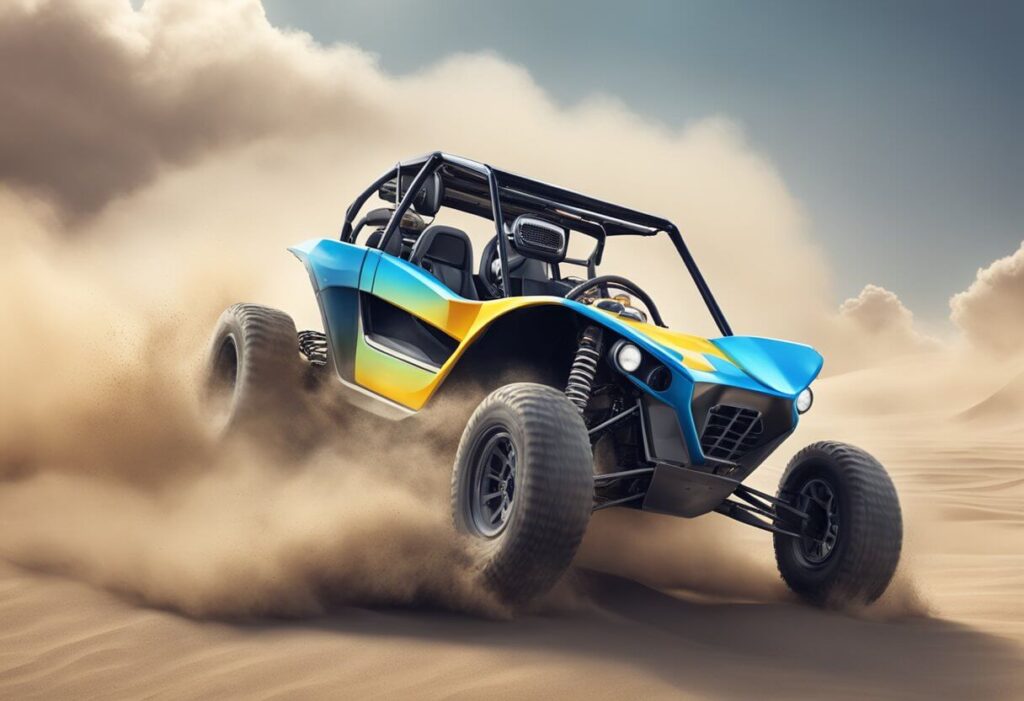
Off-road dune buggies are designed to conquer tough terrains and provide an exhilarating ride. However, to get the most out of your dune buggy, you may want to consider some performance modifications. Here are some of the most popular performance upgrades to consider:
Engine Upgrades
A powerful engine is essential for an off-road dune buggy. Upgrading your engine can give you more horsepower and torque, which translates to better acceleration and top speed. Popular engine upgrades include turbochargers, superchargers, and engine swaps. However, it’s important to keep in mind that engine modifications can be expensive and may require additional modifications to other parts of the vehicle.
Tire Customization
Tires are one of the most important components of an off-road dune buggy. The right tires can provide better traction, stability, and handling on different terrains. Customization options include tire size, tread pattern, and tire type. It’s important to choose tires that are appropriate for the type of terrain you’ll be driving on.
Drivetrain Enhancements
Drivetrain enhancements can improve the performance of your dune buggy in a variety of ways. Upgrading your suspension system can provide better shock absorption and handling on rough terrain. Other drivetrain enhancements include upgrading your transmission, differential, and axles. These modifications can improve your vehicle’s off-road capabilities and performance.
Overall, performance modifications can enhance the capabilities and fun factor of your off-road dune buggy. However, it’s important to research and choose modifications that are appropriate for your vehicle and driving style. Always consult with a professional mechanic or off-road specialist before making any modifications to your vehicle.
Off-Road Racing Events
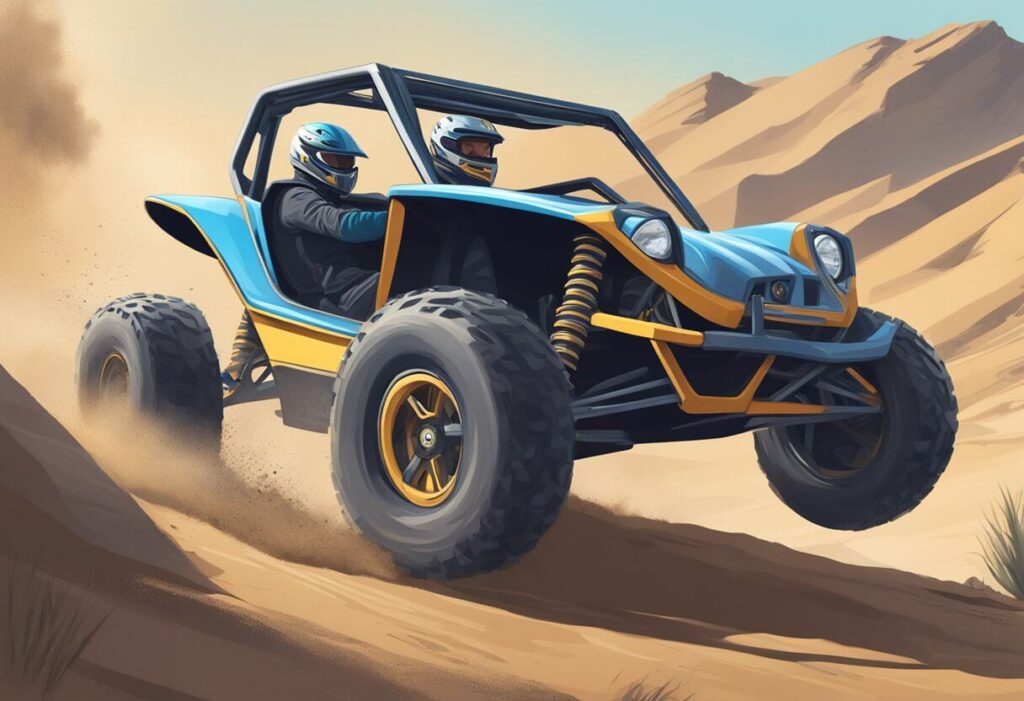
Off-road dune buggies are designed for off-road racing, and there are many events that cater to this type of racing. The events range from competitive racing to recreational events.
Competitive Racing
Competitive racing events are designed for professional racers who want to test their skills against other racers. These events are usually organized by professional racing organizations and require racers to have a certain level of skill and experience.
One such event is the IOK Spring Fling Race, which is part of the Outlaw Sand Drag Series. It features lots of sand drag and off-road vehicles tearing down the IOK 4 Wheeler’s sand drag strip in Cleves, Ohio. This two-day event is open to the public, and tickets are cheap.
Another competitive racing event is the COR – Dirt City Off-Road National, which takes place at the Dirt City Motorplex in Lena, Wisconsin. This event is part of the Championship Off-Road Racing series and features professional racers competing in various off-road races.
Recreational Events
Recreational events are designed for people who want to enjoy off-road racing without the pressure of competition. These events are usually organized by off-road clubs or groups and are open to anyone who has an off-road vehicle.
One such event is the Las Vegas Off Road Experience, which offers various off-road racing packages for people of all skill levels. They offer a Dune Buggy Package that allows people to roll around their 1-mile off-road professional race track with one of their Pro Dune Buggies. They also offer a Razor Package that allows people to get some air time driving in a razor on their 1-mile off-road professional track.
Another recreational event is the Dune Buggy Race Package, which is also offered by the Las Vegas Off Road Experience. This package includes a complimentary pickup from your Las Vegas Strip hotel, a professional Dune Buggy for 5, 7, or 10 laps, and lunch that includes a World Famous All-American Burger, Fries, and Soda.
Legal and Environmental Considerations
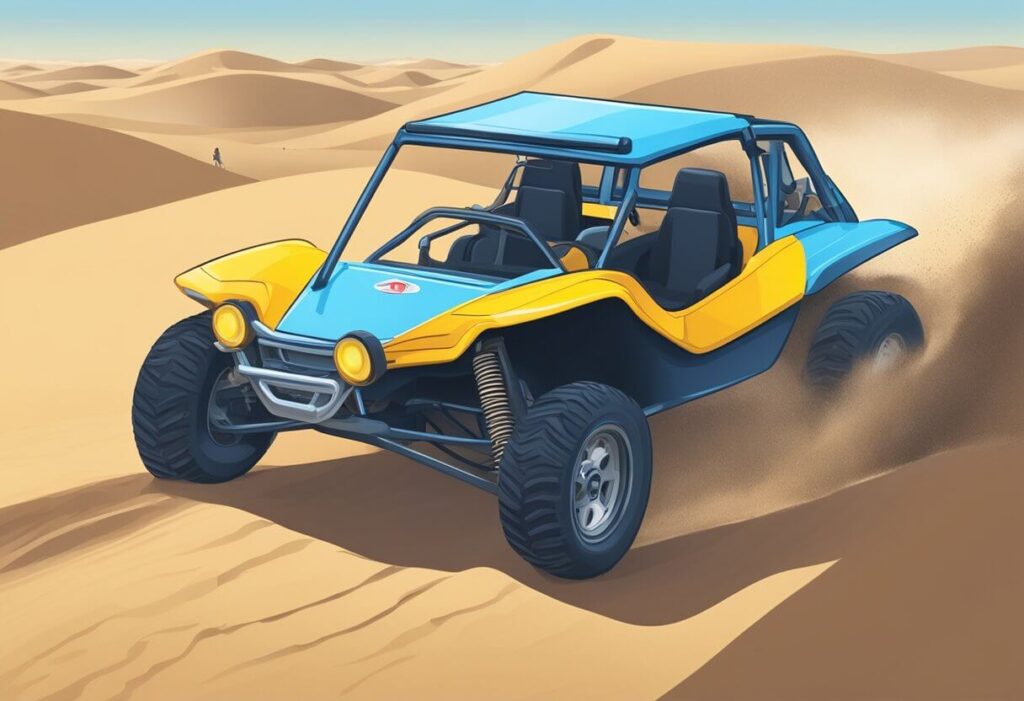
Regulations and Permits
Before taking an off-road dune buggy out for a spin, it is important to understand the regulations and permits required in the area. In the United States, the laws regarding off-road vehicles vary from state to state. While some states allow dune buggies to be operated on public roads, others have strict regulations that prohibit their use.
It is important to check with local authorities to determine the specific regulations in the area. Additionally, some states require permits for off-road vehicles, which can be obtained from the state’s Department of Motor Vehicles. Failure to comply with local regulations and permit requirements can result in fines and legal consequences.
Environmental Impact
Off-road dune buggies can have a significant impact on the environment, particularly in fragile ecosystems such as sand dunes. The heavy weight of the vehicle can cause erosion and damage to vegetation, which can have long-term effects on the ecosystem.
To minimize the impact on the environment, it is important to stick to designated off-road trails and avoid driving through sensitive areas. Additionally, dune buggies should be properly maintained to reduce emissions and prevent leaks that can contaminate the soil and water supply.
By being aware of the regulations and environmental impact, off-road dune buggy enthusiasts can enjoy their hobby while minimizing their impact on the environment and avoiding legal consequences.
Maintenance and Care
Routine Servicing
Regular maintenance is essential for keeping an off-road dune buggy in top condition. This includes checking the oil, filters, and spark plugs, as well as inspecting the brakes, suspension, and tires. It is recommended to follow the manufacturer’s guidelines for service intervals and to keep a record of all maintenance performed. This will help ensure the longevity and reliability of the vehicle.
Repair Tips
Off-road dune buggies are designed to take a beating, but they still require repairs from time to time. Common issues include flat tires, broken suspension components, and damaged bodywork. It is important to have a basic understanding of the vehicle’s mechanics and to carry a toolkit and spare parts when going on a ride. If a repair is beyond the scope of the owner’s abilities, it is recommended to seek professional assistance.
Cleaning and Storage
Proper cleaning and storage are crucial for maintaining the appearance and functionality of an off-road dune buggy. After each ride, the vehicle should be washed down with water and a mild detergent to remove dirt and debris. It is also recommended to apply a protective coating to the bodywork and to lubricate moving parts. When not in use, the vehicle should be stored in a dry, cool place and covered with a breathable cover to prevent dust and moisture buildup.
Buying Guide

New vs. Used
When it comes to buying an off-road dune buggy, one of the first decisions to make is whether to buy new or used. A new dune buggy will likely come with a warranty and be in pristine condition, but it will also come with a higher price tag. On the other hand, a used dune buggy will likely be less expensive, but it may not be in as good of condition and may not come with a warranty.
Budget Considerations
Before purchasing a dune buggy, it’s important to consider your budget. Dune buggies can range in price from a few thousand dollars to tens of thousands of dollars. It’s important to set a budget and stick to it. Keep in mind that there may be additional costs beyond the purchase price, such as maintenance, repairs, and upgrades.
Inspection Checklist
When inspecting a dune buggy, there are several things to look for to ensure you are getting a quality product. Here is a checklist of some important features to consider:
- Chassis: Look for any signs of damage or wear and tear on the chassis. Check for any cracks or rust.
- Engine: Check the engine for any leaks, corrosion, or damage. Make sure it starts easily and runs smoothly.
- Suspension: Check the suspension for any signs of damage or wear and tear. Make sure it is working properly and the shocks are in good condition.
- Tires: Check the tires for any damage or wear and tear. Make sure they have good tread and are properly inflated.
- Brakes: Check the brakes for any signs of wear and tear. Make sure they are working properly and are not worn down.
- Electrical System: Check the electrical system for any issues. Make sure all lights and signals are working properly.
By considering these factors, you can ensure that you are getting a quality off-road dune buggy that will provide you with years of enjoyment.
Frequently Asked Questions
What factors determine the price of an off-road dune buggy?
The price of an off-road dune buggy can vary depending on several factors, such as the quality of the parts used, the complexity of the design, and the level of customization. Generally, the more advanced and high-quality the parts are, the more expensive the dune buggy will be. Customization can also add to the cost, as it requires additional labor and materials.
How do I choose the best off-road dune buggy for my needs?
When choosing an off-road dune buggy, it is important to consider your intended use and personal preferences. Factors such as engine power, suspension, and size can all impact the performance of the dune buggy. Additionally, you should consider the terrain you will be driving on and the level of experience you have with off-roading.
What are the legal requirements for owning and operating a dune buggy?
The legal requirements for owning and operating a dune buggy vary depending on the state or country you are in. In general, dune buggies must meet certain safety standards and be registered and insured. It is important to research the specific laws and regulations in your area before purchasing and operating a dune buggy.
Which engines are commonly used in off-road buggies for optimal performance?
There are several engines commonly used in off-road dune buggies, including Volkswagen air-cooled engines, Subaru engines, and Honda engines. Each engine has its own strengths and weaknesses, and the best engine for your dune buggy will depend on your specific needs and preferences.
Can dune buggies be used for everyday driving, or are they strictly for off-roading?
While dune buggies are primarily designed for off-roading, some models can be used for everyday driving. However, due to their open design and lack of amenities, they may not be the most practical or comfortable option for daily use.
How does a 4×4 dune buggy’s performance compare to a standard ATV on rough terrain?
A 4×4 dune buggy generally offers better performance on rough terrain than a standard ATV, as it has a more stable and balanced design and can handle higher speeds. However, the specific performance will depend on the individual dune buggy and ATV models being compared.

